The Full Harvest Supermoon Covers Saturn and Dips into Earth’s Umbra, Evening Neptune Peaks near Saturn, the Big Bear Prepares to Nap, and Autumn Arrives!

The bright rays that surround the small bright crater Proclus are missing to the left of the two yellow lines, evidence that the Proclus impactor arrived at a shallow angle from that direction and tossed debris in front of it, partly onto dark Mare Crisium. This feature on the moon is easy to see in binoculars. Another single pair of rays streak to the left from the small crater Messier in dark Mare Fecunditatis at bottom centre. Ray systems like this are best seen on nights when the moon is close to full every month.
Hello, mid-September Stargazers!
Here are your Astronomy Skylights for the week of September 15th, 2024 by Chris Vaughan. Feel free to pass this along to your friends and send me your comments, questions, and suggested topics. You can also follow me on Twitter as @astrogeoguy! Unless otherwise noted, all times are expressed in Eastern Time. To subscribe to these emails please click this MailChimp link.
If you’d like me to bring my Digital Starlab portable inflatable planetarium to your school or other daytime or evening event in Simcoe, Grey, and Bruce Counties, or deliver a virtual session anywhere, contact me through AstroGeo.ca, and we’ll tour the Universe, or the Earth’s interior, together! My book with John A. Read entitled 110 Things to See With a Telescope is a guide to viewing the deep sky objects in the Messier List – for both beginners and seasoned astronomers. DM me to order a signed copy!
When the moon becomes full on Tuesday it will be the Harvest Moon, a supermoon, and partially eclipsed by dipping into Earth’s shadow. It will also occult Saturn! Meanwhile the planets will continue to shine from sunset to sunrise, including Neptune at peak visibility in evening, the Big Bear will be a “dipper”, and northern autumn will arrive, so we review Earth’s axis. Read on for your Skylights!
The Big Bear Readies for Hibernation
Have you tried looking for the Big Dipper lately? In mid-September every year, that asterism, which is circumpolar for observers located north of 35° North latitude, drops lower during the evening and reaches its lowest position above the northern horizon toward midnight – as if it is scooping up a bowl of cold, refreshing northern water! Its stars might not even clear the treetops where you live.
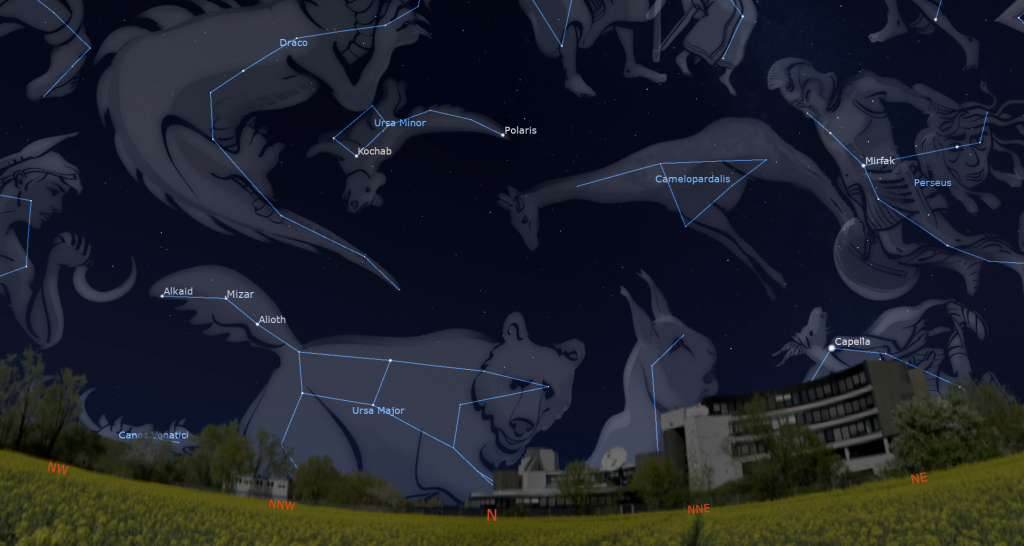
North American indigenous traditions tell the tale of the Great Bear (Ursa Major) heading into her den for winter. Wounded by pursuing birds represented by the Big Dipper’s handle stars Alkaid, Mizar, and Alioth, the bear’s blood dripped to Earth, staining the fall foliage red. In another story, those three stars are hunters pursuing the bear. The little star Alcor shining close beside Mizar represents that hunter’s little dog. Come spring, the bear will emerge from her slumber and begin to climb the northeastern evening sky.
Happy Equinox and Other Musings
Due to the Earth’s orbital motion around the sun and the tilt of our rotation axis, autumn will begin in the Northern Hemisphere and spring will arrive in the Southern Hemisphere next Sunday, September 22 at 8:44 am EDT, 5:44 am PDT, or 12:44 Greenwich Mean Time. The timing of the astronomical seasons is independent of your location on Earth.
Allow me to elaborate…
As Earth travels around the sun (completing one orbit every year), our perspective change makes the sun appear to migrate continuously eastward through the distant background stars. (We can’t see those stars in daytime, but we can see the brightest ones near the sun after sunset and before sunrise – and we can easily see the constellations change over as weeks roll by.)
The circular path that the sun traces around the celestial sphere is called the ecliptic. Ancient skywatchers noted that, in the course of one year, the sun passed through the same twelve (well, thirteen actually) constellations – avoiding all the others. Those “special constellations” became the zodiac. The sun entered and exited each zodiac constellation on the same dates every year – leading to the astrology sun sign idea that many still follow.
The sun doesn’t precisely “re-trace its steps” every year. You see, the Earth, as a “spinning top”, is precessing because it is not a perfect sphere and the sun and moon tug on its imperfections. Earth’s two polar axes (one north and one south) each point to a spot on the sky called the celestial pole. Earth’s northern axis is currently aimed 27.5 arc-minutes (a bit less than the moon’s apparent diameter) away from Polaris, the North Star. That’s close enough for regular folks to use Polaris to identify the north celestial pole, but astronomers’ telescopes need to be precisely aligned to the true pole. The spot on the horizon below Polaris will always be geographic north – making it incredibly helpful for finding directions at night. By the way, the height of Polaris above the horizon will be equal to your latitude on Earth – a boon to ancient mariners. Polaris is famous for those reasons, and not because it’s a particularly bright star, as many assume.

Due to the slow wobble of precession, Earth has – and will continue to – trace out a circle of 47° in diameter in the stars over an interval that repeats every 25,765 years. During that interval the celestial pole will pass through the constellations of Ursa Minor (the Little Bear), Cepheus (the King), and the northern parts of Cygnus (the Swan), Lyra (the Harp), and Hercules – allowing various stars to take turns shining near our pole. The very bright star Vega will become Earth’s pole star again around 13,500 AD.
The precession ring almost completely encloses the constellation of Draco (the Dragon) and passes closer to its star Thuban (aka Alpha Draconis) than it does to Polaris. Thuban was Earth’s pole star during the Sumerian civilization Bronze Age and just before the “Age of the Pyramid Builders” in Egypt. The indigenous Dakota/Lakota of North America have long envisaged Wakiåyaå, a great Thunderbird constellation, inside the precession circle – evidence for the great length of time they have been watching the skies and their understanding of the changes that occur over many thousands of years! The northern polar axis of the sun and many of the major planets point to parts of Draco, too.
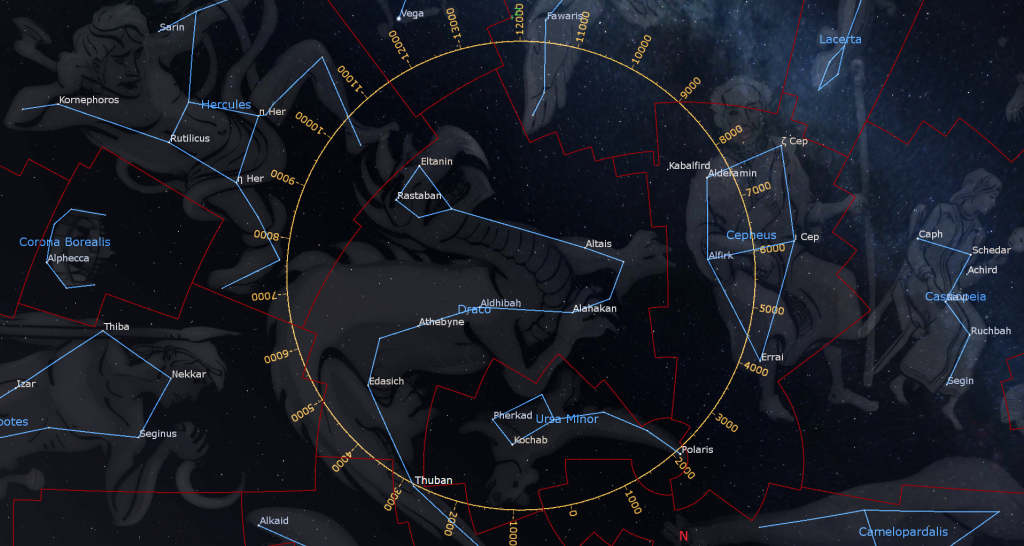
The Earth’s precession also makes the sun creep westward along the ecliptic by 50.2 arc-seconds per year, or about a thumb’s diameter every century. Several thousand years ago, the equinoxes were called the First Point of Aries and the First Point of Libra because those constellations hosted the sun in March and September. Since then, precession has caused the two equinox points to shift by one zodiac constellation to the west, messing up the old star sign definitions.
Okay – let’s get back to talking about the September equinox…
The Earth’s axis of rotation is tilted 23.5° away from the ecliptic – so an imaginary circle painted on the sky directly overhead of our equator passes through a different group of stars than does the ecliptic. In fact, that celestial equator divides the celestial sphere into two great bowls comprising the Northern Hemisphere stars and the Southern Hemisphere stars. Since the Earth’s equator is to the south for observers in the Northern Hemisphere, the celestial equator is always in the southern region of our sky, and it arcs from the eastern horizon to the western horizon.
You can think of the equator and ecliptic circles as two hula hoops sharing the same centre – us. Since one hoop is tilted by 23.5° compared to the other one, the two circles only intersect at two spots in the sky, one in western Virgo (the Maiden) and the other in western Pisces (the Fishes). The sun reaches those spots during the third weeks of March and September, respectively. Another way of thinking about it is that half of the ecliptic runs through stars in the southern celestial hemisphere, and the other half runs through northern stars – so the sun spends half of the year among northern stars and the other half among southern stars.
At every equinox, the sun meets one of the two intersection points – as if it is “stepping over” the equator. The full disk of the sun takes about 13 hours to cross the equator – but we define the equinox as the moment when the centre of the sun slips across. The equinoxes and solstices are global events. Just correct by the appropriate number of hours to determine when northern autumn will begin in your own time zone.
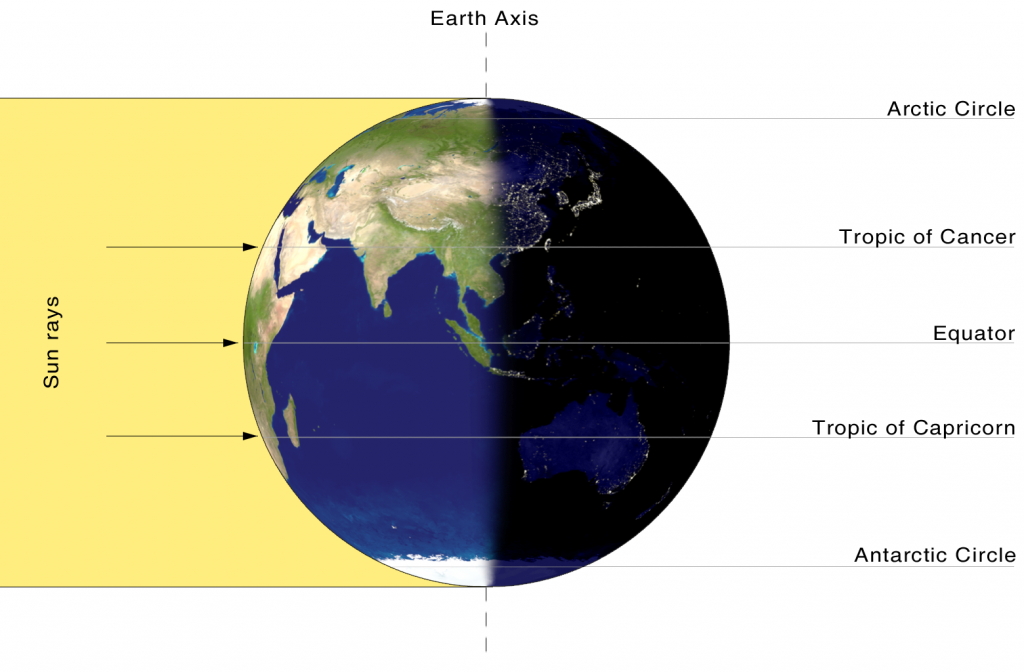
On the September, or autumnal, equinox the sun is entering the southern bowl of the sky. Six months later, on the vernal equinox, it will cross the celestial equator at the other intersection point and re-enter the northern bowl of the sky. At that moment, spring will begin for the Northern Hemisphere. (I like to avoid using the seasonal terms “vernal” and “autumnal” because the seasons are swapped for people living in the Southern Hemisphere.) The solstices occur about mid-way between the equinoxes – in late June and December.
An equinox produces several interesting effects. At either equinox, the sun rises due east and sets due west. For the six months following the September equinox, the sun will spend all of each day among the Southern Hemisphere stars, and climb high in the sky for the lucky folks who live there! The higher sun will take more daylight hours to cross the sky and will deliver more highly-concentrated solar radiation, producing warmer weather. (Compare the intensity of a flashlight’s light when it’s beamed straight at a wall versus obliquely at the wall. The bright circle of light gets weaker when it’s spread into an oval.) During the same months, North Americans, Europeans, and Asians have to accept shorter, colder days and longer nights (which are great for warmly dressed astronomers). On the day of the equinox, everyone on Earth experiences 12 hours each of day-time and night-time (unless you live near the North Pole where the sun won’t drop low enough below the horizon to darken the sky). This is where the term equinox, Latin for “equal night”, comes from.
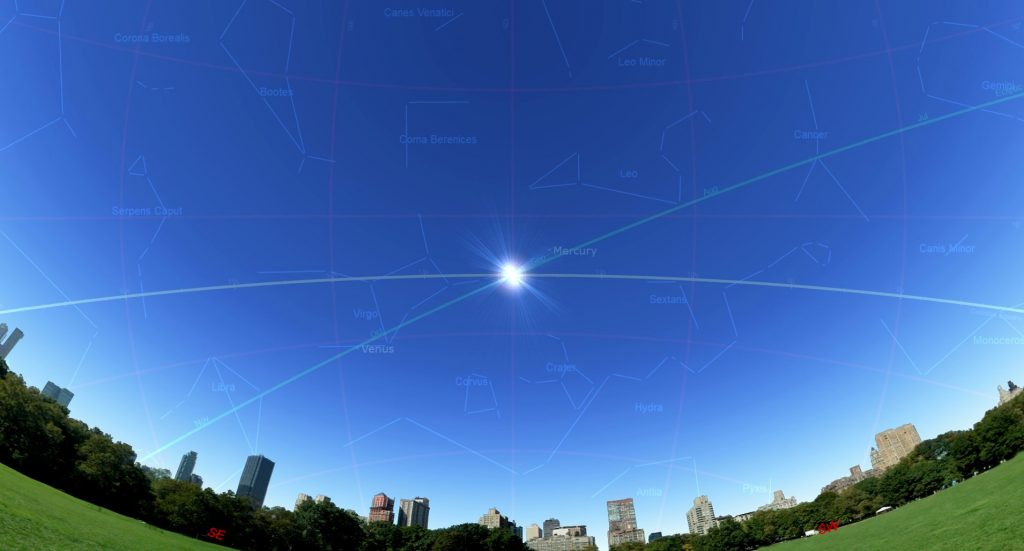
The nights around the equinoxes offer a higher likelihood of the Northern Lights, or aurorae, at high northern and southern latitudes. Just as two bar magnets lined up with their poles in the same direction repel one another strongly, the Earth’s magnetic field repels the sun’s field. At the equinoxes, the Earth’s axis tilts partly sideways compared to the sun, so those two “magnets” aren’t lined up as well, reducing Earth’s ability to deflect the sun’s field and the charged particles that trigger aurorae in our upper atmosphere.
At this time in September every year, the Earth is travelling almost directly towards the stars that mark the upraised club of Orion (the Hunter) and the toes of Gemini (the Twins). In a few weeks, that geometry will produce the “bugs on a windshield” effect when the Orionids meteor shower particles strike the Earth’s upper atmosphere and produce the streaks of light we see. Also at this time, Earth is travelling almost directly away from the stars of Sagittarius (the Archer) and Ophiuchus (the Water-Bearer).
What I’ve described above forms the astronomical definition of the seasons. The dates that each season begins on each year vary a little because Earth’s year is 365.2425 days. That extra 5.82 hours per year adds up until we eliminate most of it using the February 29 Leap Day every four years. The rest of the fraction is cleaned up by skipping Leap Day on most of the years that end with “00”. The meteorological definition of the seasons declares that northern autumn begins on September 1 and ends on November 30 – and so on through the year for winter, spring, and summer.
The Moon
The moon will get up to some interesting things this week while it floods the night sky worldwide with moonlight.
Tonight (Sunday) the bright, 94%-illuminated gibbous moon will rise an hour before sunset. It will outshine the faint stars of Capricornus (the Sea-Goat) that surround it while it crosses the sky. The prominent dot off to its left will be Saturn. In the Great Lakes region, a thick blanket of forest fire smoke has been tinting the moon brown every night. Objects climb to their highest point in the sky when they are due south. Astronomers call that culmination. When the moon does that around 11:30 pm in your local time zone, it will only be low in the sky because its orbit is well below the ecliptic nowadays.
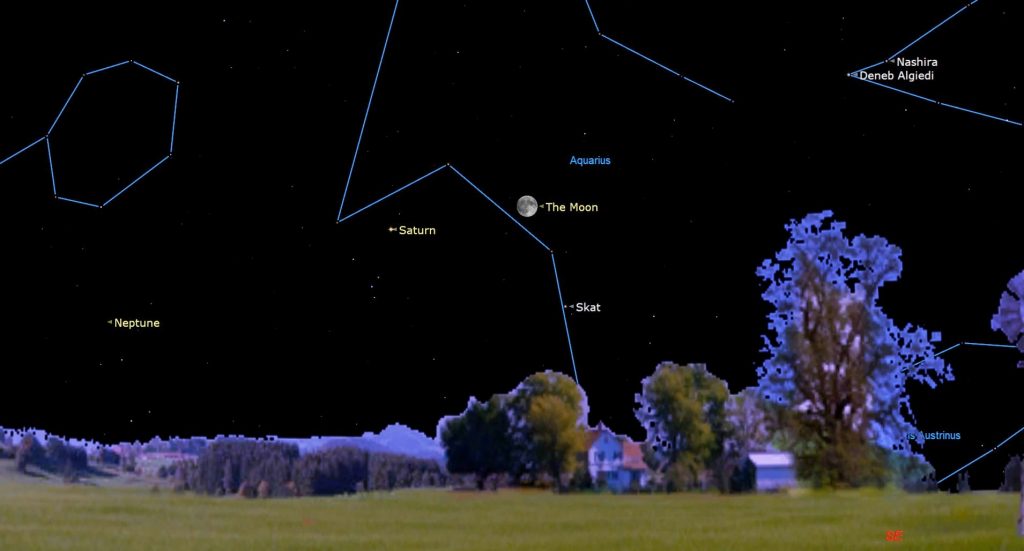
After the waxing gibbous moon clears the eastern rooftops in early evening on Monday, the yellowish dot of Saturn will shine closer on its left (or celestial northeast). As the pair cross the sky overnight, the moon’s continuous eastward orbital motion (by its own diameter every hour) will carry it closer to Saturn. Meanwhile, the diurnal rotation of the sky will lift Saturn above the moon by the time they set in the west before dawn. Observers on the west coast of North America and within a zone extending south and west to northern Australia, Melanesia, southern and eastern Micronesia, and northwestern Polynesia (including Hawaii) can watch the moon pass in front of (or occult) Saturn on Tuesday morning. Use an app like Starry Night to look up the occultation timings for your location and enjoy the event with your unaided eyes – or even better – through binoculars or a backyard telescope!
The moon will officially reach its full phase on Tuesday, September 17 at 10:34 pm EDT or 7:34 pm PDT (which converts to 02:34 GMT on Wednesday). With perigee arriving only 10 hours later, this full moon will also be the second of four supermoons in 2024. Supermoons occur in consecutive groups or three or four – about every 14 lunations (or lunar months). During those periods, the moon’s 27.32-day sidereal orbital period that causes perigees and apogees (i.e., when the moon is closest and farther from Earth, respectively) temporarily synchs up with the 29.53-day synodic period that produces the moon’s phases. An astrologer named Richard Nolle appears to have coined the term “supermoon” in 1979. Over the years he has refined his definition that the moon be full while it is also within 90% of its closest approach to Earth. Sky & Telescope magazine uses 358,884 km from Earth as the cutoff and the website Timeanddate.com uses 360,000 km. Interestingly, because the Earth is spherical, a given full moon can be super in the tropics and not super at high latitudes, which are farther from the moon.
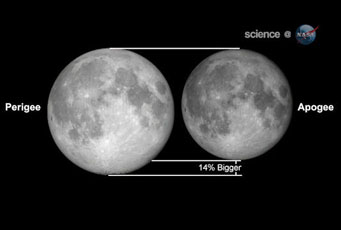
Supermoons appear up to 7% larger than an average full moon, but about 16% brighter than an average full moon due to the inverse square law. The world experiences higher perigean tides due to supermoons’ proximity to Earth. The October 17 full moon will be the largest supermoon of 2024, by a smidge. The final one on November 15 will be super, too – but slightly smaller.
The astronomical term for a supermoon is lunar perigee-syzygy but, unlike the media, astronomers don’t typically pay extra attention to the moon at that time since it’s rather dull-looking in a telescope at that time. Don’t forget that any moon, even a supermoon, can easily be covered by a pinky fingernail held at arm’s length and sighted with one eye closed. That rule even applies to little children’s tiny fingers!
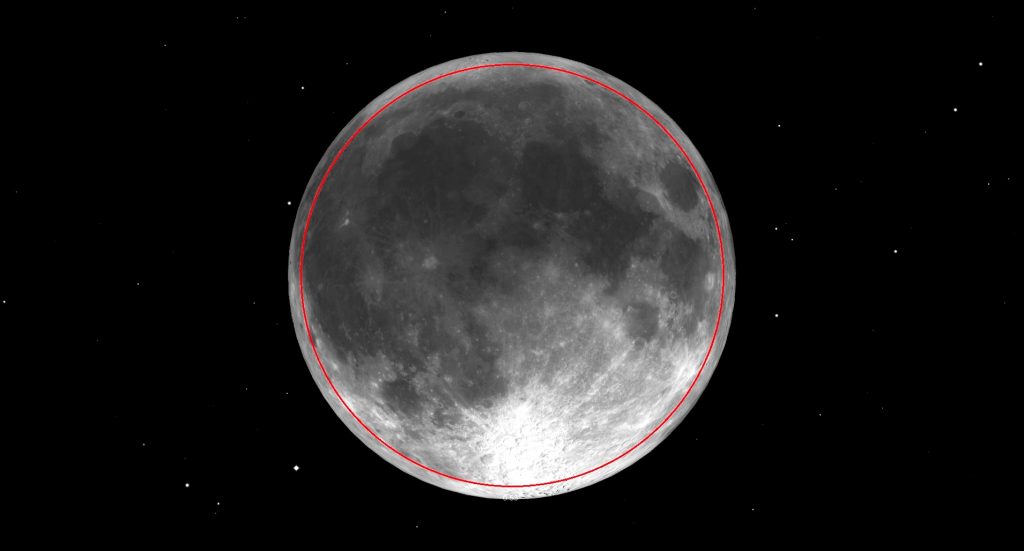
The September full moon, traditionally known as the Corn Moon and Barley Moon, always shines in or near the stars of Aquarius (the Water-Bearer) or Pisces (the Fishes). The indigenous Anishinaabe people of the Great Lakes region call this moon Waatebagaa-giizis or Waabaagbagaa-giizis, the “Leaves Turning Moon” or “Leaves Falling Moon”. The Cree Nation of central Canada calls the September full moon Nimitahamowipisim, the “Rutting Moon” – when the bull moose scrapes the velvet from his antlers as a sign that mating shall begin. The Haudenosaunee (Iroquois) of Eastern North America call it Seskehko-wa, the “Time of Much Freshness Moon”.
Because this is the full moon occurring closest to the autumnal equinox in 2024, it is also the harvest moon. On the evenings around its full phase, the moon normally rises about 50 minutes later than the previous night. But around the equinox the shallow slope of the evening ecliptic (and the moon’s orbit) causes harvest moons to rise at almost the same time each night – only delayed by as little as 10 minutes, depending on your latitude. For Toronto latitudes, the delay is about 20 minutes.
The harvest moon phenomenon traditionally allowed farmers to work into the evening under bright moonlight – hence its name. It also means that if you arrive home from work, get the mail, or walk the dog at the same time every evening, you might notice the “full” moon for several days in a row. The effect is stronger the farther from the equator you live. I’ll post a diagram that explains the phenomenon here. The moon behaves the same way for Southern Hemisphere dwellers – but six months later, near their own autumnal equinox in March.
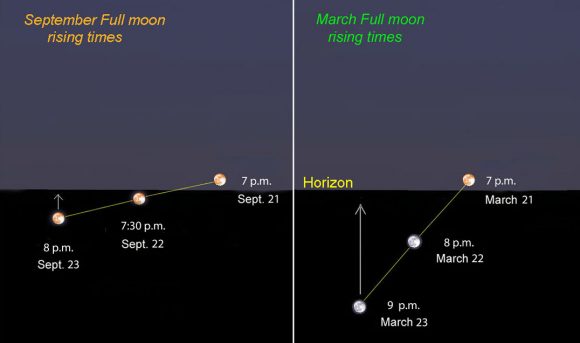
While no shadows are being cast on a full moon, the light and dark areas on the full moon are only due to different rock types on the moon’s surface. The bright areas are the ancient, heavily-cratered lunar highlands composed of crystalline anorthosite rock, and the dark areas are younger maria, iron-rich basalts that have filled the oldest deep basins and which have fewer craters. The nights around full are also the best ones for seeing the bright ray systems surrounding the younger craters on the moon – material that was blasted out during the impact that formed the crater, and by the secondary impacts of the excavated chunks of rock.
The impact that created the bright crater Tycho, which is located in the south-central area of the moon, produced streaks of bright material that extend in multiple directions across the moon’s near side. Another particularly interesting ray system surrounds the crater Proclus. The small, 27 km wide crater and its ray system are visible in binoculars at the lower left edge of Mare Crisium, the round grey basin near the moon’s upper right edge (northeast on the moon). The Proclus rays, about 600 km in length, only appear on the eastern, right-hand side of the crater, and within Mare Crisium, suggesting that the impactor that made the crater arrived at a shallow angle from the southwest. The small crater Menelaus on the southern edge of Mare Serenitatis hosts some small rays. A long, possibly unrelated, ray passes through both Menelaus and the mare. (Note that east and west are reversed on the moon).
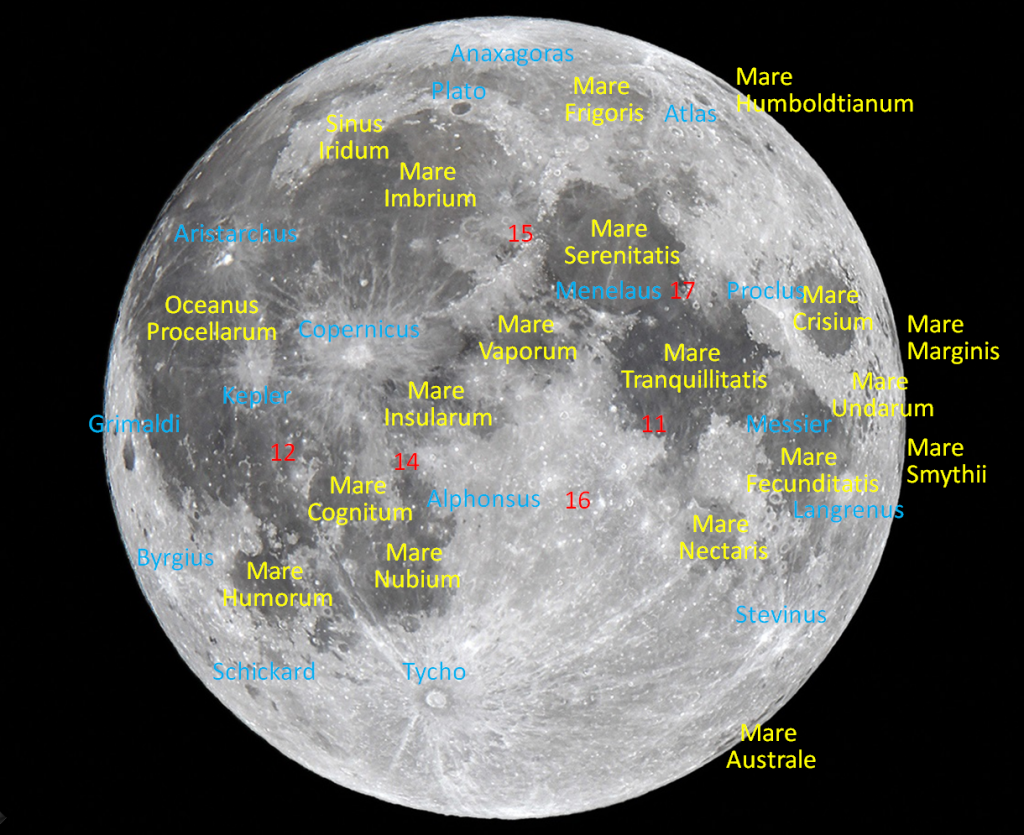
But wait – there’s more! The northerly edge of this full moon will also dip into Earth’s shadow (or umbra) for 63.7 minutes, generating a shallow partial lunar eclipse visible across the Americas (except Alaska), the Atlantic Ocean, and western Europe and Africa. The moon will begin to enter Earth’s partial shadow ring (or penumbra), slightly darkening it, at 8:41 pm EDT. A small “bite” out of the moon will be visible between 10:13 pm and 11:16 pm EDT, with a maximum of 8.5% of the moon embedded within Earth’s shadow at 10:45 pm EDT. The moon will fully emerge from Earth’s penumbra at 12:48 am EDT.
Lunar eclipses are completely safe to look at without protective filters. You might not notice the penumbral darkening – but you should be able to see the nibble in binoculars or any telescope.
After Tuesday, the moon will rise about 22 minutes later each night and wane in phase. On Wednesday and Thursday it will swim through Pisces (the Fishes) and appear low in the west at sunrise. It will spend Friday in Aries (the Ram).
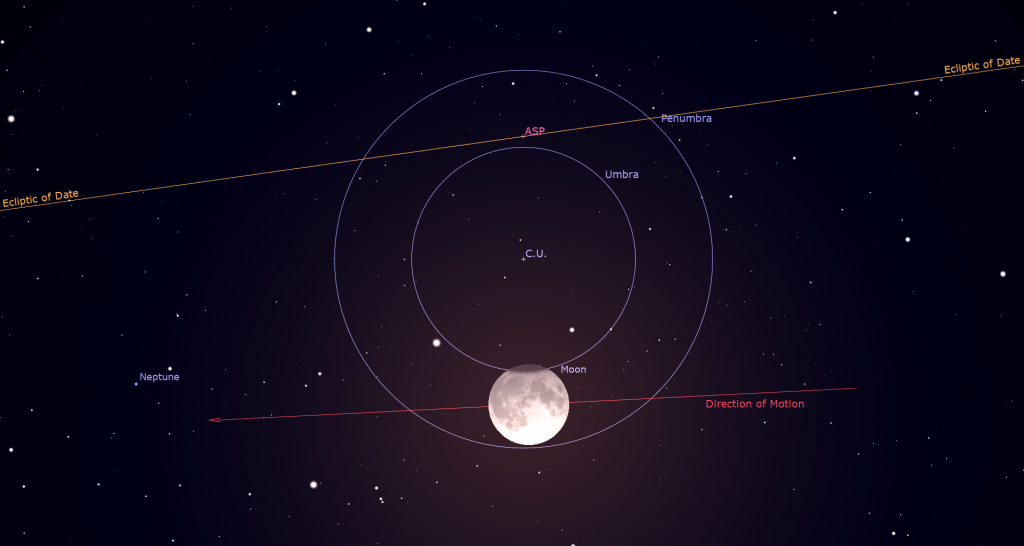
When the still very bright, waning gibbous moon rises over the rooftops to the east on Saturday evening, the bright little cluster known as the Pleiades, the Seven Sisters, the Hole in the Sky, Matariki, and Messier 45 will be sparkling several finger widths to the moon’s lower left – close enough for them to share the view in binoculars. To better see the cluster’s stars, which are spread over an area nearly four times larger than the moon, hide the moon beyond the upper right edge of your binoculars’ field of view. Skywatchers viewing the scene later at night, and in more westerly time zones, will see the moon approach closer to the cluster, pass among its stars around 7 am EDT or 11:00 GMT, and then begin to move off to their east.
The moon will end this week shining brightly above Jupiter in Taurus (the Bull) next Sunday night.
The Planets
With Mercury sinking into the sunrise now, we’re down to six observable planets. The speedy, innermost planet will spend a while over the western post-sunset horizon during October-November, but observers at mid-northern latitudes won’t be able to easily see that apparition. Our next good views will be before sunrise during the weeks around Christmas. Earlier this week, you might glimpse Mercury around 6:30 am local time – but it will be low, and lower each morning!
Venus, too, is being held low in the west after sunset this month by the slanted evening ecliptic, but its magnitude -3.86 brilliance may allow folks with unobstructed, cloud-free western horizons to spot the planet for a short period after sunset. You can start to look for Venus’ very bright dot starting around 7:30 pm local time. The planet will be the bright, star-like object gleaming less than a fist’s width above the horizon. Wait until the sun has fully set before using binoculars. Folks living closer to the tropics are already seeing Venus gleaming between the palm trees after sunset.
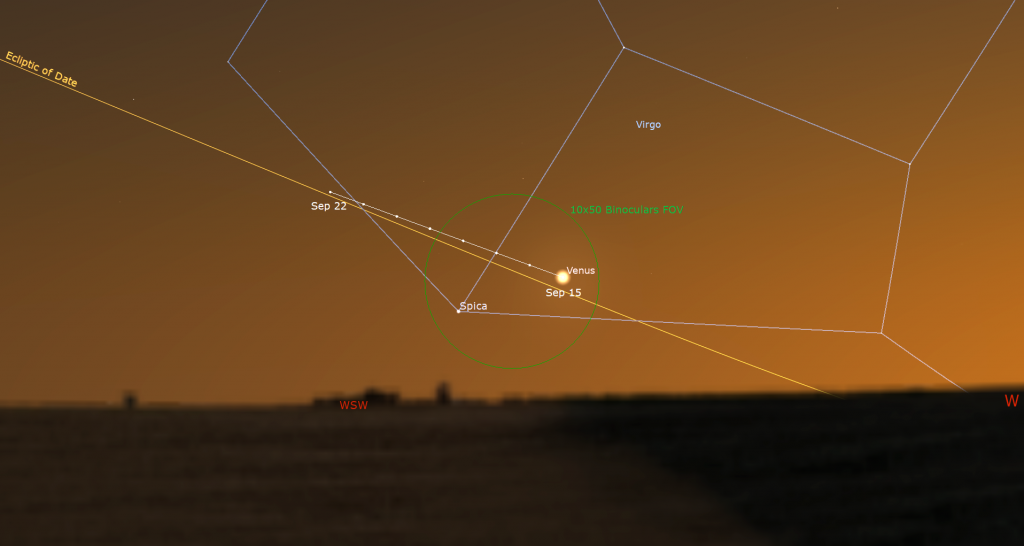
Saturn is our top attraction every evening. After last week’s opposition, the ringed gem will rise just before the sun sets and clear the eastern rooftops by about 8:15 pm – but you’ll get the clearest views of Saturn in a telescope when it’s higher in the sky between 9 pm and 4 am. (Thankfully, those times are advancing by half an hour each week.) The faint stars of Aquarius (the Water-Bearer) will be shining just to the right of Saturn. Binoculars will show you a bent-line trio of stars named Psi Aquarii sparkling to Saturn’s lower right. The lower two are white, while the higher one is golden. Two redder stars named Phi and Chi Aquarii will appear to Saturn’s upper and lower right, respectively.
Saturn’s rings will effectively disappear when they become edge-on to Earth next March. They already look like a thick line drawn through the planet’s globe. Good binoculars can hint that Saturn has rings, and any size of telescope will show them, and Saturn’s moons! In most years, Saturn’s moons are spread all around the planet – unlike Jupiter’s Galileans moons, which are always in a line. But Earth’s perspective of the Saturn system this year and next year is making its moons line up with the rings.
Saturn’s largest and brightest moon Titan never wanders more than five times the width of Saturn’s rings from the planet. The much fainter moon named Iapetus “eye-YA-pet-us” can stray up to twelve times the ring width during its 80-day orbit of Saturn. The next brightest moons Rhea “REE-ya”, Dione “Dee-OWN-ee”, Tethys “Teth-EES”, Enceladus “En-SELL-a-dus”, and Mimas “MY-mass” all stay within one ring-width of Saturn.
During this week, Titan will move from the lower left of Saturn (or celestial west of it) tonight, pose closely below Saturn on Tuesday, and then stretch far to Saturn’s right (celestial west) on the coming weekend. (Remember that your telescope will probably flip the view around.) The rest of the moons will be tiny specks in a line beyond the rings. You may be surprised at how many you can see through your telescope if you look closely.
Earth’s perspective of the Saturn system will also cause Saturn’s moons and their small black shadows to frequently cross its disk – but you’ll need a very high quality telescope to watch those. Tethys and its tiny shadow will cross Saturn just south of the rings on Tuesday night from 11:53 pm to 2:35 am EDT. Tethys and shadow will cross again from 9:09 to 11:58 pm EDT on Thursday.
On Friday night, September 20, Neptune will reach opposition. That will be its closest approach to Earth for this year – a distance of “merely” 4.32 billion km, 4 light-hours, or 28.9 Astronomical Units. At opposition, blue Neptune will shine with a slightly enhanced magnitude of 7.8. Since it will be opposite the sun in the sky, Neptune will be visible all night long in backyard telescopes, but the best time to look at Neptune will be while it’s higher up and the sky is dark – between about 9:30 pm and 5 am local time. Good binoculars can capture Neptune if your sky is very dark – but unfortunately, Neptune will have to share the sky with a very bright moon this week. Around opposition, Neptune’s apparent disk size will peak at 2.4 arc-seconds and its large moon Triton will be the most visible.
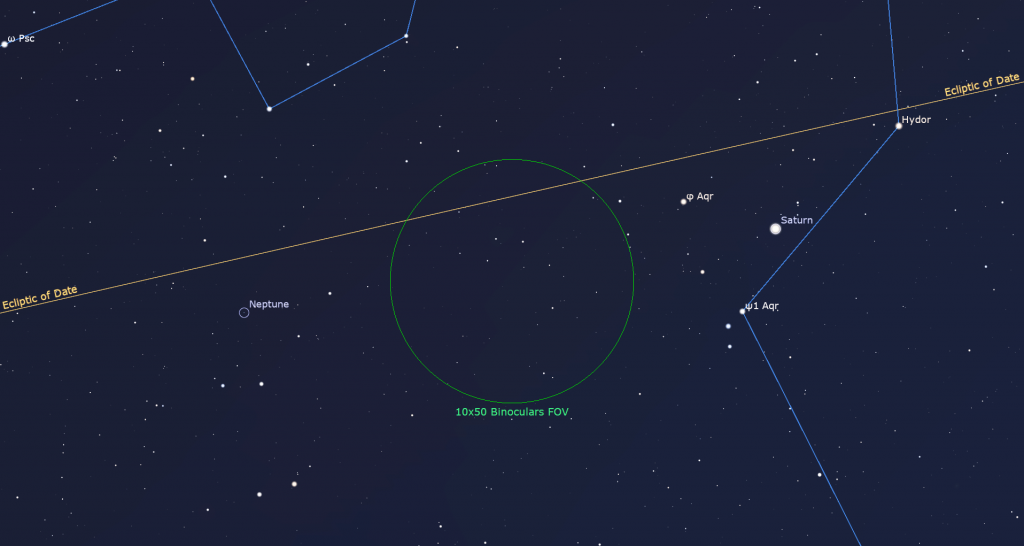
Neptune will rise 25 minutes after Saturn and follow it across the sky every night. The distant, blue planet will be spending this year in western Pisces (the Fishes), about 1.3 fist widths to the left (or 13° to the celestial ENE) of Saturn. Neptune doesn’t move very quickly through the stars. Neptune will also be located a palm’s width below the circle of stars that forms Pisces’ western fish, and about two finger widths above (or 2° celestial north) of the upright rectangle formed by the medium-bright stars 27, 29, 30, and 33 Piscium.
Three more planets will shine in the sky from the wee hours until dawn.
If you live at mid-northern latitudes, Jupiter will be rising in the east around 11 pm local time and clear the eastern rooftops by about 12:30 am. The planet will climb high into the southern sky by sunrise. Jupiter is shining between the horns of Taurus (the Bull), about a fist’s width to the left (or 10° to the celestial ENE) of his brightest star, reddish Aldebaran. The reddish, 16 times fainter dot of Mars will appear to the lower left of Jupiter – like a reflection of Aldebaran. Mars’ relatively faster orbital motion will increase its separation from Jupiter a little more each morning.
Any binoculars will show Jupiter’s four Galilean moons named Io, Europa, Ganymede, and Callisto lined up beside the planet. Those moons complete orbits of the planet every 1.7, 3.6, 7.2, and 16.7 days, respectively. If you see fewer than four moons, then one or more of them is crossing in front of or behind Jupiter, or hiding in Jupiter’s dark shadow – or two of the moons are very close together, or one moon is eclipsing or occulting another one.
Even a small, but decent quality telescope can show you Jupiter’s dark belts and light zones, which are aligned parallel to its equator. With a better grade of optics, Jupiter’s Great Red Spot, a cyclonic storm that has raged for hundreds of years, becomes visible for several hours when it crosses the planet every 2nd or 3rd night. For observers in the Americas, that GRS will cross Jupiter’s disk in the wee hours of Tuesday, Thursday, and next Sunday, and before dawn on Monday, Wednesday, and Saturday morning. If you have any coloured filters or nebula filters for your telescope, try enhancing the spot with them.
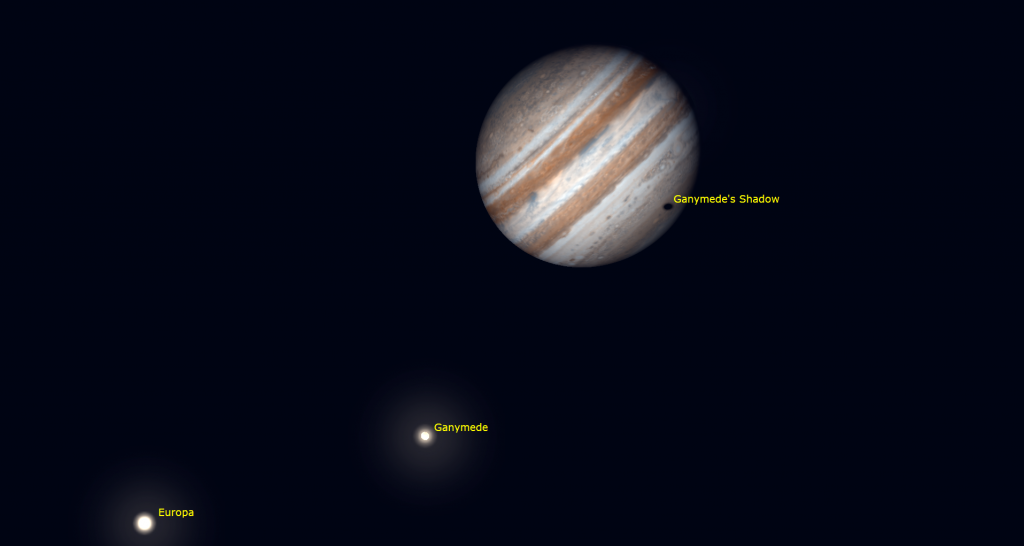
From time to time, observers with good quality telescopes can watch the black shadows of the Galilean moons travel across Jupiter’s disk. For those in Europe and Africa, the large black shadow of Ganymede will cross Jupiter’s southern latitudes on Friday, September 20 from 10:53 pm to 12:40 am EDT (or 02:53 to 04:40 GMT on Saturday).
Mars will rise about 70 minutes after Jupiter, follow the giant planet upwards, and fade into the morning twilight before Jupiter does. In a telescope, the red planet will appear as a small, rusty-coloured disk. Its position on the far side of the sun from Earth, 200 million km distant, will keep the planet looking small until later this year. This week, Mars will only be 88%-illuminated because its angle from the sun is 78°. The planet will spend this week trekking eastward through the feet of Castor in Gemini (the Twins).
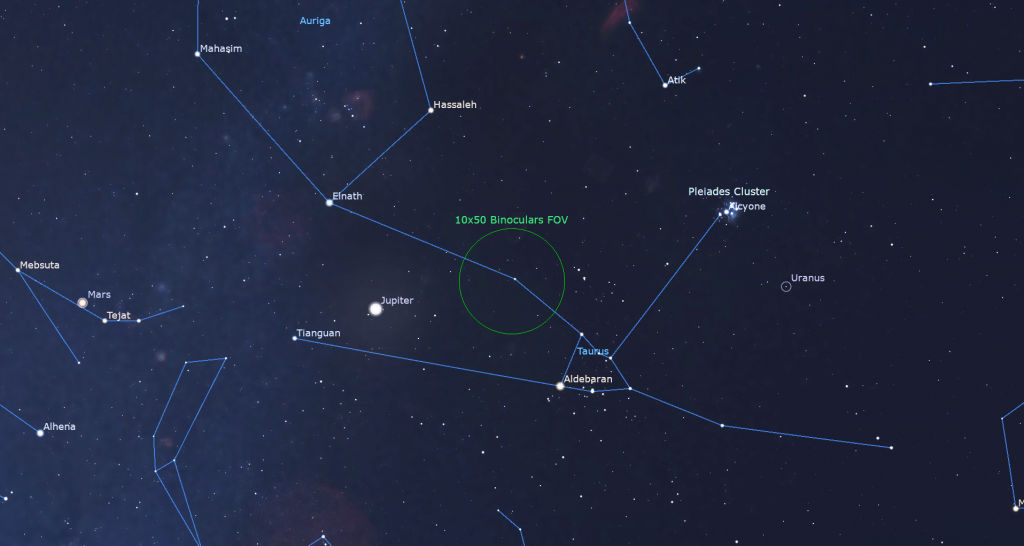
Uranus will spend this year as a non-twinkling, blue-green star positioned about a palm’s width to the lower right of the bright Pleiades star cluster in Taurus (the Bull). The slow-moving, distant planet will remain near those scattered gems until 2027! Uranus will precede Jupiter across the night sky each night. It will rise around 10:45 pm local time and become high enough for viewing in binoculars or a backyard telescope from about 11:30 pm to until the sky begins to brighten before dawn. Uranus will be creeping westward in a retrograde loop until the end of January.
Public Astronomy-Themed Events
Every Monday evening, York University’s Allan I. Carswell Observatory runs an online star party – broadcasting views from four telescopes/cameras, answering viewer questions, and taking requests! Details are here. They host in-person viewing on the first clear Wednesday night each month. Other Wednesdays they stream views online via the observatory YouTube channel. Details are here.
At 7:30 pm on Wednesday, September 18, the RASC Toronto Centre will livestream their free monthly Speaker’s Night Meeting. The speaker will be Dr. Chris Matthew, Western Sydney University, Australia. His topic will be Overview of Findings at Tall el-Hammam, Jordan. Check here for details and watch the presentation at https://www.youtube.com/rasctoronto/live.
On Friday, September 20 from 9 to 11 pm, RASC Toronto Centre will host Family Night at the David Dunlap Observatory for visitors aged 7 and up. You will tour the sky, visit the giant 74” telescope, and view celestial sights through telescopes if the sky is clear. This program runs rain or shine. Details are here, and the link for tickets is at ActiveRH.
Keep your eyes on the skies! I love getting questions and requests. Send me some!